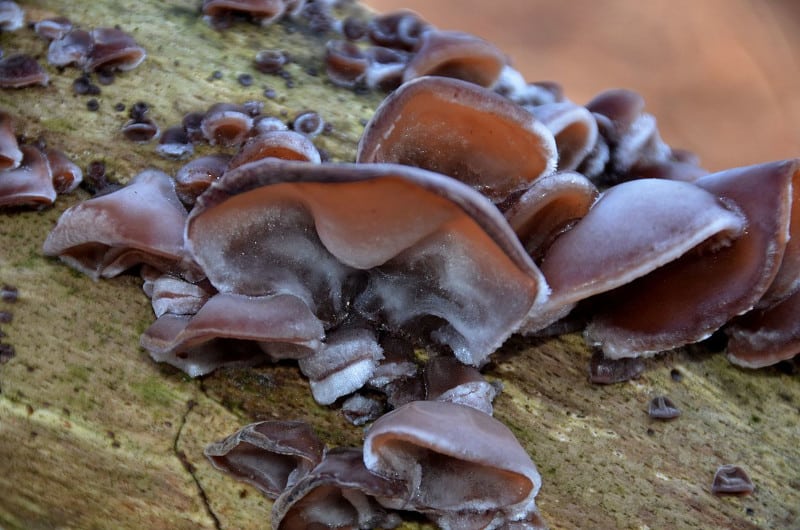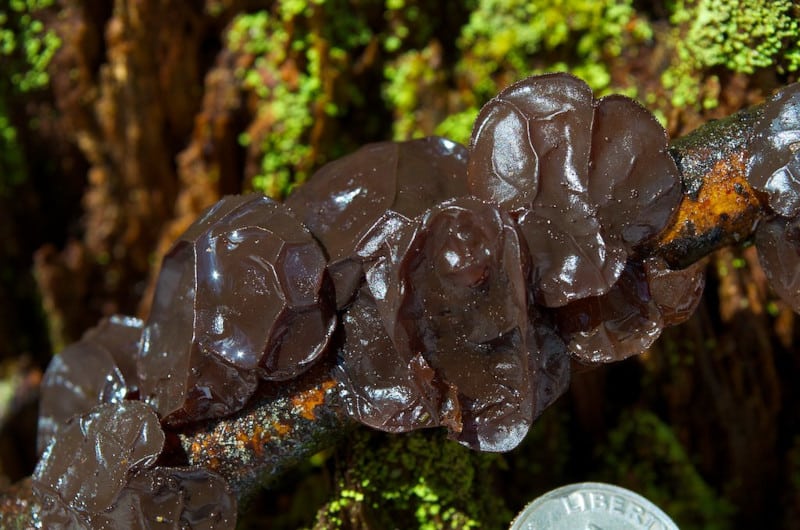
Jelly Ear Facts
- This highly distinctive variety of fungus most frequently goes by the simple yet descriptive common name of the Jelly Ear. Like many species, though, it also bears other, alternate names. These include such terms as the Jew’s Ear and the Judas’s Ear.
- Among professionals, such as researchers, however, it’s better known by its technical name. That term, though, as such things do, remains quite difficult for the layperson to pronounce. That’s because it holds the technical name of Auricularia auricula-judae.
- Its naming took a circuitous path. The noted Swedish botanist, Carl Linnaeus recorded the first known description of the mushroom, in 1753. Later, however, the French botanist Jean Bulliard renamed it. It received the name it presently holds in 1822.
- The Jelly Ear appears to presently be maintaining a population base that’s both stable and sufficient. This fortunate fact further seems to hold true throughout the entirety of its native range. The IUCN therefore presently has no listing for it on its Red List.
- The marvel of Nature nevertheless must be considered as facing at least some threats to its continued existence. These, though, remain the same most species face. Habitat loss certainly qualifies. Its greatest threat, however, likely consists of climate change.
Related Articles
Jelly Ear Physical Description
The Jelly Ear is an intriguing variety of fungus. It fully merits the attention it garners from those who encounter it. It further does so due to several factors. Its sheer size qualifies as one of those. Though by no means the largest, it’s an above-average sized specimen.
Individual specimens sometimes attain a diameter of as much as 3.5 in (9 cm). Most, however, tend to remain slightly smaller than that. It also achieves a thickness of up to 0.12 in (3 mm). Each specimen, though, tends to develop in its own unique exact shape.
But overall, examples of the species develop as a shape often compared to that of a floppy human ear. That therefore serves as the origin of the most often used name. Some examples, though, occasionally display a different shape. These typically appear cup-shaped.
Most examples of the Jelly Ear attach themselves laterally to a surface. This means these do not possess a stalk. A small percentage of them, do, however, develop this feature. Among these less common forms, the stalk nevertheless remains extremely short in length.
While living, the body displays a tough, gelatinous texture that’s slightly elastic to the touch. The majority of the upper surface also displays a reddish-tan shade. This same part of the fungus also often possesses a light purplish hue. It also frequently manifests tiny gray hairs.
- Kingdom: Fungi
- Phylum: Basidiomycota
- Class: Agaricomycetes
- Order: Auriculariales
- Family: Auriculariaceae
- Genus: Auricularia
- Species: A. auricula-judae
Jelly Ear Distribution, Habitat, and Ecology
The remarkable Jelly Ear evolved as native to an extremely large swathe of the globe. Not surprisingly, that same region’s already well known for its abundance of intriguing flora and fauna. That’s because this wonder of Nature developed natively in what’s now Europe.
In fact, the fascinating fungus appears in virtually all parts of this beautiful continent. Intriguingly, however, evidence additionally indicates that it never existed naturally beyond this region. Related species live in other parts of the world, but not this specific fungus.
It also displays decided preferences for where it appears. This primarily consists of areas of temperate forest. The natural wonder even manifests preferences for which types of hosts. This consists almost exclusively of several species of deciduous trees and shrubs.
This intriguing product of evolution most commonly develops on elder trees. Other, less popular, hosts include spindle, ash, beech, and sycamore. Conifers, though, rarely play host to this particular fungus. It also prefers to develop on older, or even dead, branches.
The Jelly Ear most frequently develops as a solitary species. It nevertheless does occasionally develop in small clusters. Fascinatingly, it also makes appearances throughout the year, even in winter. Its numbers do usually tend to be fewer during that season, though.
Like other fungi, this unique looking variety reproduces via the spreading of spores. In its particular case, however, it ejects these from the underside of the fruit body. It also produces and ejects as many as several hundred thousand of these spores per hour!
Species Sharing Its Range
Check out our other articles on 4 Perfectly Pleasing Palms, Texas Blind Salamander, Laguna Verde, Caspian Seal, Canary Island Date Palm, Black Mamba, Peacock Butterfly

